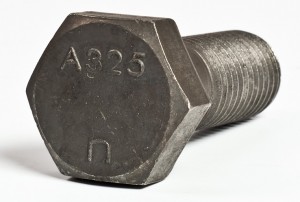 While these two bolts are virtually identical in terms of chemical and physical strengths and properties, there are several differences between the two. The Grade 5 specification falls under the Society of Automotive Engineers (SAE) classification system, while A325 is an ASTM specification. ASTM A325 bolts are more commonly specified by engineers for use in structural steel connections on heavy construction projects, while SAE Grade 5 bolts are more common in OEM-type applications.
While these two bolts are virtually identical in terms of chemical and physical strengths and properties, there are several differences between the two. The Grade 5 specification falls under the Society of Automotive Engineers (SAE) classification system, while A325 is an ASTM specification. ASTM A325 bolts are more commonly specified by engineers for use in structural steel connections on heavy construction projects, while SAE Grade 5 bolts are more common in OEM-type applications.
Grade 5 bolts are most typically made, and are most readily available in a finished hex bolt configuration. A325 bolts are required to have a heavy hex head. The same thing applies for the compatible nuts. Grade 5 nuts are a finished hex pattern, and A194-2H or A563-DH heavy hex nuts are required for use with A325 bolts.
Another difference is that Grade 5 bolts may be specified from 1/4″ diameter up to and including 1-1/2″ diameter. The A325 specification covers bolts from 1/2″ up to and including 1-1/2″ diameter. For bolts larger than 1-1/2″, ASTM A449 should be specified.
Lastly, the required thread lengths are different. Grade 5 fasteners, like most grades, have a standard thread length of twice the diameter plus 1/4″ for bolt lengths less than or equal to 6″ and twice the diameter plus 1/2″ for bolt lengths 6″ and longer. A325 bolts have specific thread lengths, based on the diameter of the bolt, that are shorter than most other bolt grades.
Is the grade 5 bolt as strong in structural application
@Charles- I am not completely sure I understand your question. Grade 5 bolts are similar in strength to A325 structural bolts but they are not identical.
Very useful Technical Information.
Thank You
IS THERE ANY DIFFERENCE BETWEEN THE BS AND AMERICAN STANDARD ANCHOR BOLTS.
Mohammed, there are many direct correlations or near correlations between the British Standards and the ASTM standards. I do not have a cross reference sheet, but if you have a specific standard you are looking at, perhaps we can help you find the rough equivalent.
Why do A325 bolts and Grade 5 bolts have different tightening torques listed in your suggested starting torque values when the bolts have the same chemical and physical properties?
@Sean McCarthy – Application. A325 structural bolts (and A490s) are specifically used for steel to steel structural connections and are typically tensioned beyond their yield point when installed, whereas SAE grade 5 bolts are used for many general purpose applications and are not normally installed that way.
I know that an A325 heavy hex bolt head and heavy hex nut will develop the full tensile strength of the bolt, provided that the threads of the nut are fully engaged. Is the same true for a Grade 5 bolt? Can Grade 5 bolts be designed similarly to A325 bolts in tension in lighter (non-structural) applications?
@Kyle Shaver – You are correct that A325 structural bolts and SAE grade 5 hex bolts are similar in chemistry and mechanical values. A325 bolts are typically used in steel to steel structural connections whereas Grade 5s are typically used in OEM and general purpose applications. We can’t really make recommendations as to which bolt is best for which application, but, being that the two bolts are similar, one could reasonably assume that the Grade 5s could be used in applications where the strength of an A325 is desired, but the application is something other than a structural steel connections.